Endometrial resection and ablation versus hysterectomy for heavy menstrual bleeding
- PMID: 33619722
- PMCID: PMC8095059
- DOI: 10.1002/14651858.CD000329.pub4
Endometrial resection and ablation versus hysterectomy for heavy menstrual bleeding
Abstract
Background: Heavy menstrual bleeding (HMB) is common in otherwise healthy women of reproductive age, and can affect physical health and quality of life. Surgery is usually a second-line treatment of HMB. Endometrial resection/ablation (EA/ER) to remove or ablate the endometrium is less invasive than hysterectomy. Hysterectomy is the definitive treatment and can be via open (laparotomy) approach, or via minimally invasive approaches (vaginally or laparoscopically). Each approach has its own advantages and risk profile.
Objectives: To compare the effectiveness, acceptability and safety of endometrial resection or ablation versus different routes of hysterectomy (open, minimally invasive hysterectomy, or unspecified route) for the treatment of HMB.
Search methods: We searched the Cochrane Gynaecology and Fertility specialised register, CENTRAL, MEDLINE, Embase and PsycINFO (July 2020), and reference lists, grey literature and trial registers.
Selection criteria: Randomised controlled trials (RCTs) that compared techniques of endometrial resection/ablation with hysterectomy (by any technique) for the treatment of HMB in premenopausal women.
Data collection and analysis: We used standard methodological procedures expected by Cochrane.
Main results: We included 10 RCTs (1966 participants) comparing EA/ER to hysterectomy (open (abdominal), minimally invasive (laparoscopic or vaginal), or unspecified (or at surgeon's discretion) route of hysterectomy). The results were rated as moderate-, low- and very low-certainty evidence. Endometrial resection/ablation versus open hysterectomy We found two trials. Women having EA/ER are probably less likely to perceive an improvement in HMB compared to women having open hysterectomy (risk ratio (RR) 0.90, 95% confidence interval (CI) 0.84 to 0.95; 2 studies, 247 women; moderate-certainty evidence) and probably have a 13% risk of requiring further surgery for treatment failure (compared to 0 on the open hysterectomy group; 2 studies, 247 women; moderate-certainty evidence). Both treatments probably lead to similar quality of life at two years (mean difference (MD) -5.30, 95% CI -11.90 to 1.30; 1 study, 155 women; moderate-certainty evidence) and satisfaction rate at one year (RR 0.91, 95% CI 0.82 to 1.00; 1 study, 194 women; moderate-certainty evidence). There may be no difference in serious adverse events (RR 1.29, 95% CI 0.32 to 5.20; 2 studies, 247 women; low-certainty evidence). EA/ER probably reduces time to return to normal activity compared to open hysterectomy (MD -21.00 days, 95% CI -24.78 to -17.22; 1 study, 197 women; moderate-certainty evidence). Endometrial resection/ablation versus minimally invasive hysterectomy We found five trials. The proportion of women with perception of improvement in HMB at two years may be similar between groups (RR 0.97, 95% CI 0.90 to 1.04; 1 study, 79 women; low-certainty evidence). Blood loss may be higher in the EA/ER group when assessed using the Pictorial Blood Assessment Chart (MD 44.00, 95% CI 36.09 to 51.91; 1 study, 68 women; low-certainty evidence). Quality of life is probably lower in the EA/ER group compared to the minimally invasive hysterectomy group at two years according to the 36-item Short Form (SF-36) (MD -10.71, 95% CI -15.11 to -6.30; 2 studies, 145 women; moderate-certainty evidence) and Menorrhagia Multi-Attribute Scale (RR 0.82, 95% CI 0.70 to 0.95; 1 study, 616 women; moderate-certainty evidence). EA/ER probably increases the risk of further surgery for HMB compared to minimally invasive hysterectomy (RR 7.70, 95% CI 2.54 to 23.32; 4 studies, 922 women; moderate-certainty evidence) and treatments probably have similar rates of any serious adverse events (RR 0.75, 95% CI 0.35 to 1.59; 4 studies, 809 women; moderate-certainty evidence). Women with EA/ER are probably less likely to be satisfied with treatment at one year (RR 0.90, 95% CI 0.85 to 0.94; 1 study, 558 women; moderate-certainty evidence). We were unable to pool data for time to return to work or normal life because of extreme heterogeneity (99%); however, the three studies reporting this all had the same direction of effect favouring EA/ER. Endometrial resection/ablation versus unspecified route of hysterectomy We found three trials. EA/ER may lead to a lower perception of improvement in HMB compared to unspecified route of hysterectomy (RR 0.89, 95% CI 0.83 to 0.95; 2 studies, 403 women; low-certainty evidence). Although EA/ER may lead to similar quality of life using the SF-36 General Health Perception at two years' follow-up (MD -1.90, 95% CI -8.67 to 4.87; 1 study, 209 women; low-certainty evidence), the proportion of women with improvement in general health at one year may be lower (RR 0.85, 95% CI 0.77 to 0.95; 1 study, 185 women; low-certainty evidence). EA/ER probably has a risk of 5.4% of requiring further surgery for treatment failure (compared to 0 with total hysterectomy; 2 studies, 374 women; moderate-certainty evidence) and reduces the proportion of women with any serious adverse event (RR 0.21, 95% CI 0.06 to 0.80; 2 studies, 374 women; moderate-certainty evidence). Both treatments probably lead to a similar satisfaction rate at one year' follow-up (RR 0.96, 95% CI 0.88 to 1.04; 3 studies, 545 women; moderate-certainty evidence). EA/ER may lead to shorter time to return to normal activity (MD -18.90 days, 95% CI -24.63 to -13.17; 1 study, 172 women; low-certainty evidence).
Authors' conclusions: Endometrial resection/ablation (EA/ER) offers an alternative to hysterectomy as a surgical treatment for HMB. Effectiveness varies with EA/ER compared to different hysterectomy approaches. The perception of improvement in HMB with EA/ER is probably lower compared to open and unspecified route of hysterectomy, but may be similar compared to minimally invasive. Quality of life with EA/ER is probably similar to open and unspecified route of hysterectomy, but lower compared to minimally invasive hysterectomy. Further surgery for treatment failure is probably more likely with EA/ER compared to all routes of hysterectomy. Satisfaction rates also vary. EA/ER probably has a similar rate of satisfaction compared to open and unspecified route of hysterectomy, but a lower rate of satisfaction compared to minimally invasive hysterectomy. The proportion having any serious adverse event appears similar in all groups, but specific adverse events did reported difference between EA/ER and different routes. We were unable to draw conclusions about the time to return to normal activity, but the direction of effect suggests it is likely to be shorter with EA/ER.
Copyright © 2021 The Cochrane Collaboration. Published by John Wiley & Sons, Ltd.
Conflict of interest statement
MBR: none.
AL: none.
RJF: none.
Figures
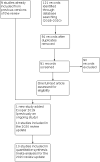
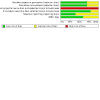


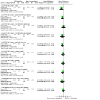

















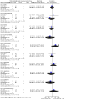


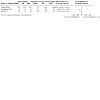
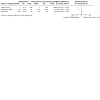

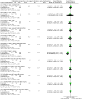


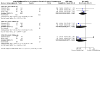







Update of
-
Endometrial resection and ablation versus hysterectomy for heavy menstrual bleeding.Cochrane Database Syst Rev. 2019 Aug 29;8(8):CD000329. doi: 10.1002/14651858.CD000329.pub3. Cochrane Database Syst Rev. 2019. Update in: Cochrane Database Syst Rev. 2021 Feb 23;2:CD000329. doi: 10.1002/14651858.CD000329.pub4. PMID: 31463964 Free PMC article. Updated.
References
References to studies included in this review
Cooper 2019 {published data only}
-
- Cooper K, Breeman S, Scott N, Scotland G, Clark J, Hawe J, et al, on behalf of the HEALTH Study Group. Laparoscopic supracervical hysterectomy versus endometrial ablation for women with heavy menstrual bleeding (HEALTH): a parallel-group, open-label, randomised controlled trial. Lancet 2019;394(10207):1425-36. [DOI: ] - PMC - PubMed
-
- Cooper K, McCormack K, Breeman S, Wood J, Scott NW, Clark J, et al. HEALTH: laparoscopic supracervical hysterectomy versus second-generation endometrial ablation for the treatment of heavy menstrual bleeding: study protocol for a randomised controlled trial. Trials 2018;19(1):63. [DOI: ] - PMC - PubMed
Crosignani 1997 {published data only}
-
- Crosignani PG, Vercellini P, Apolone G, De Giorgi O, Cortesi I, Meschia M. Endometrial resection versus vaginal hysterectomy for menorrhagia: long-term clinical and quality-of-life outcomes. American Journal of Obstetrics and Gynecology 1997;177(1):95-101. - PubMed
Dickersin 2007 {published data only}
-
- Dickersin K, Munro M, Langenberg P, Scherer R, Frick KD, Weber AM, et al. Surgical treatments outcomes project for dysfunctional uterine bleeding (STOP-DUB): design and methods. Controlled Clinical Trials 2003;24(5):591-609. - PubMed
-
- Dickersin K, Munro MG, Clark M, Langenberg P, Scherer R, Frick K, et al. Hysterectomy compared with endometrial ablation for dysfunctional uterine bleeding. Obstetrics and Gynecology 2007;110(6):1279-89. - PubMed
-
- Munro M, Dickerson K, Clark M, Langenberg P, Scherer R, Frick K. The Surgical Treatments Outcomes Project for Dysfunctional Uterine Bleeding: summary of an Agency for Health Research and Quality-sponsored randomized trial of endometrial ablation versus hysterectomy for women with heavy menstrual bleeding. Menopause 2011;18(4):451-8. - PubMed
Dwyer 1993 {published data only}
-
- Dwyer N, Hutton J, Stirrat GM. Randomised controlled trial comparing endometrial resection with abdominal hysterectomy for the surgical treatment of menorrhagia. British Journal of Obstetrics and Gynaecology 1993;100(3):237-43. - PubMed
-
- Sculpher M. A cost-utility analysis of abdominal hysterectomy versus transcervical endometrial resection for the surgical treatment of menorrhagia. International Journal of Technology Assessment in Health Care 1998;14(2):302-19. - PubMed
-
- Sculpher MJ, Bryan S, Dwyer N, Hutton J, Stirrat GM. An economic evaluation of transcervical endometrial resection versus abdominal hysterectomy for the treatment of menorrhagia. British Journal of Obstetrics and Gynaecology 1993;100(3):244-52. - PubMed
-
- Sculpher MJ, Dwyer N, Byford S, Stirrat GM. Randomised trial comparing hysterectomy and transcervical endometrial resection: effect on health related quality of life and costs two years after surgery. British Journal of Obstetrics and Gynaecology 1996;103(2):142-9. - PubMed
Gannon 1991 {published data only}
Jain 2016 {published data only}
-
- Jain P, Rajaram S, Gupta B, Goel N, Srivastava H. Randomized controlled trial of thermal balloon ablation versus vaginal hysterectomy for leiomyoma-induced heavy menstrual bleeding. International Journal of Gynaecology and Obstetrics 2016;135(2):140-4. [doi.org/10.1016/j.ijgo.2016.04.020] - PubMed
O'Connor 1997 {published data only}
-
- O'Connor H, Broadbent JA, Magos AL, McPherson K. Medical Research Council randomised trial of endometrial resection versus hysterectomy in management of menorrhagia. Lancet 1997;349(9056):897-901. - PubMed
Pinion 1994 {published data only}
-
- Aberdeen Endometrial Ablation Trials Group. A randomised trial of endometrial ablation versus hysterectomy for the treatment of dysfunctional uterine bleeding: outcome at four years. British Journal of Obstetrics and Gynaecology 1999;106(4):360-6. - PubMed
-
- Cameron IM, Mollison J, Pinion SB, Atherton-Naji A, Buckingham K, Torgerson D. A cost comparison of hysterectomy and hysteroscopic surgery for the treatment of menorrhagia. European Journal of Obstetrics and Gynaecology 1996;70(1):87-92. - PubMed
Sesti 2011 {published data only}
-
- Sesti F, Ruggeri V, Pietropolli A, Piancatelli R, Piccione E. Thermal balloon ablation versus laparoscopic supracervical hysterectomy for the surgical treatment of heavy menstrual bleeding: a randomized study. Journal of Obstetrics and Gynaecology Research 2011;37(11):1650-7. - PubMed
Zupi 2003 {published data only}
-
- Centini G, Lazzeri L, Finco A, Afors K, Zupi E. Quality of life and risk of reintervention comparing endometrial ablation and laparoscopic subtotal hysterectomy: a 15 years follow up study. Gynecological Surgery 2015;12(Suppl 1):S11.
-
- Zupi E, Centini G, Lazzeri L, Finco A, Exacoustos C. Hysteroscopic endometrial resection versus laparoscopic supracervical hysterectomy for abnormal uterine bleeding: long term follow-up of a prospective randomised trial. Journal of Minimally Invasive Gynecology 2015;22(5):841-5. [DOI: 10.1016/j.jmig.2015.08.108] - DOI - PubMed
-
- Zupi E, Zullo F, Marconi D, Sbracia M, Pellicano M, Solima E, et al. Hysteroscopic endometrial resection versus laparoscopic supracervical hysterectomy for menorrhagia: a prospective randomised trial. American Journal of Obstetrics and Gynecology 2003;188(1):7-12. - PubMed
References to studies excluded from this review
Lin 2006 {published data only}
-
- Lin H. Comparison between microwave endometrial ablation and total hysterectomy. Chinese Medical Journal 2006;119(14):1195-7. - PubMed
Paddison 2003 {published data only}
-
- Paddison K. Menorrhagia: endometrial ablation or hysterectomy. Nursing Standard 2003;18(1):33-7. - PubMed
Additional references
Aarts 2015
Adelman 2014
Arnold 2015
-
- Arnold A, Abbott J. Endometrial ablation. Obstetrics and Gynaecology Magazine 2015;17(4):-. [www.ogmagazine.org.au/17/4-17/endometrial-ablation/]
Athanatos 2015
-
- Athanatos D, Pados G, Venetis CA, Stamatopoulos P, Rousso D, Tsolakidis D. Novasure impedance control system versus microwave endometrial ablation for the treatment of dysfunctional uterine bleeding: a double-blind, randomized controlled trial. Clinical and Experimental Obstetrics & Gynecology 2015;42(3):347-51. [PMID: ] - PubMed
Bhattacharya 2011
Bofill Rodriguez 2019
Bourdrez 2004
-
- Bourdrez P, Bongers MY, Mol BW. Treatment of dysfunctional uterine bleeding: patient preferences for endometrial ablation, a levonorgestrel-releasing intrauterine device, or hysterectomy. Fertility and Sterility 2004;82(1):160-6. - PubMed
Brazier 1993
-
- Brazier JE, Jones NM, Kind P. Testing the validity of the EuroQol and comparing it with the SF-36 health survey questionnaire. Quality of Life Research 1993;2(3):169-80. - PubMed
Bridgman 1994
-
- Bridgman SA. Increasing operative rates for dysfunctional uterine bleeding after endometrial ablation (letter). Lancet 1994;344:893. - PubMed
Clegg 2007
-
- Clegg JP, Guest JF, Hurskainen R. Cost-utility of levonorgestrel intrauterine system compared with hysterectomy and second generation endometrial ablative techniques in managing patients with menorrhagia in the UK. Current Medical Research and Opinion 2007;23(7):1673-48. - PubMed
Cooper 2011
-
- Cooper K, Lee A, Chien P, Raja E, Timmaraju V, Bhattacharya S. Outcomes following hysterectomy or endometrial ablation for heavy menstrual bleeding: retrospective analysis of hospital episode statistics in Scotland. British Journal of Obstetrics and Gynaecology 2011;118(10):1171-9. - PubMed
Coulter 1991
-
- Coulter A, Bradlow J, Agass M, Martin-Bates C, Tullock A. Outcomes of referrals to gynaecology outpatient clinics for menstrual problems: an audit of general practice records. British Journal of Obstetrics and Gynaecology 1991;98(8):789-96. - PubMed
Coulter 1994
-
- Coulter A. Trends in gynaecological surgery (letter). Lancet 1994;344:1367. - PubMed
EuroQol Group 1990
-
- EuroQol Group. EuroQol – a new facility for the measurement of health-related quality of life. Health Policy (Amsterdam, Netherlands) 1990;16(3):199-208. - PubMed
Fernandez 2011
-
- Fernandez H. Update on the management of menometrorrhagia: new surgical approaches. Gynecological Endocrinology 2011;Suppl 1:1131-6. - PubMed
Garrat 1995
-
- Garrat AM, Torgerson DJ, Wyness J, Hall MH, Reid DM. Measuring sexual functioning in premenopausal women. British Journal of Obstetrics and Gynaecology 1995;102(4):311-6. - PubMed
Garry 2005
-
- Garry R, Fountain J, Brown J, Manca A, Mason S, Sculpher M, et al. EVALUATE hysterectomy trial: a multicentre randomised trial comparing abdominal, vaginal and laparoscopic methods of hysterectomy. Health Technology Assessment 2005;8(26):1-154. [DOI: ] - PubMed
Garside 2004
-
- Garside R, Stein K, Wyatt K, Round A, Pitt M. A cost-utility analysis of microwave and thermal balloon endometrial ablation techniques for the treatment of heavy menstrual bleeding. British Journal of Obstetrics and Gynaecology 2004;111(10):1103-14. - PubMed
Geary 2019
-
- Geary R, Gurol-Urganci I, Kiran A, Cromwell D Bansi-Matharu L, Shakespeare J et al. Factors associated with receiving surgical treatment for menorrhagia in England and Wales: findings from a cohort study of the National Heavy Menstrual Bleeding Audit. BMJ 2019;9(2):e024260. [DOI: 10.1136/bmjopen-2018-024260] - DOI - PMC - PubMed
GRADEpro GDT [Computer program]
-
- McMaster University (developed by Evidence Prime) GRADEpro GDT. Version accessed prior to 17 July 2019. Hamilton (ON): McMaster University (developed by Evidence Prime), 2015. Available at gradepro.org.
Higgins 2008
Higgins 2011
-
- Higgins JP, Green S, editor(s). Cochrane Handbook for Systematic Reviews of Interventions Version 5.1.0 (updated March 2011). The Cochrane Collaboration, 2011. Available from training.cochrane.org/handbook/archive/v5.1/.
Hozo 2005
Kalampokas 2017
Kennedy 2002
-
- Kennedy AD, Sculpher MJ, Coulter A, Dwyer N, Rees M, Abrams KR, et al. Effects of decision aids for menorrhagia on treatment choices, health outcomes and costs. JAMA 2002;288(21):2701-8. - PubMed
Kumar 2016
Laberge 2015
-
- Laberge P, Leyland N, Murji A, Fortin C, Martyn P, Vilos G, et al. Endometrial ablation in the management of abnormal uterine bleeding. Journal d'Obstetrique et Gynecologie du Canada : JOGC [Journal of Obstetrics and Gynaecology Canada : JOGC] 2015;37(4):362-79. [PMID: ] - PubMed
Madhu 2009
Mahdi 2014
-
- Mahdi H, Goodrich S, Lockhart D, DeBernardo R, Moslemi-Kebria M. Predictors of surgical site infection in women undergoing hysterectomy for benign gynecologic disease: a multicenter analysis using the National Surgical Quality Improvement Program data. Journal of Minimally Invasive Gynaecology 2014;21(5):901-9. - PubMed
Munro 2011
-
- Munro MG, Critchley HO, Broder MS, Fraser IS. FIGO classification system (PALM-COEIN) for causes of abnormal uterine bleeding in nongravid women of reproductive age. International Journal of Gynaecology and Obstetrics 2011;113(1):3-13. - PubMed
Munro 2018
Nagele 1998
-
- Nagele F, Rubinger T, Magos A. Why do women choose endometrial ablation rather than hysterectomy? Fertility and Sterility 1998;69(6):1063-6. - PubMed
NICE 2007
-
- National Collaborating Centre for Women's and Children's Health. Heavy Menstrual Bleeding. London: RCOG Press, 2007. - PubMed
NICE 2018
-
- NICE guideline. Heavy menstrual bleeding: assessment and management. www.nice.org.uk/guidance/ng88 (accessed prior to 21 January 2020).
Overton 1997
-
- Overton C, Hargreaves J, Maresh M. A national survey of the complications of endometrial destruction for menstrual disorders: the MISTLETOE study. British Journal of Obstetrics and Gynaecology 1997;104(12):1351-9. - PubMed
Reid 2007
-
- Reid PC. Endometrial ablation in England – coming of age? An examination of hospital episode statistics 1989/1990 to 2004/2005. European Journal of Obstetrics and Gynecology 2007;135(2):191-4. - PubMed
Roberts 2011
Rust 1986
-
- Rust J, Bennum I, Crowe M, Golombok S. The construction and validation of the Golombok Rust Inventory of Marital State. Sexual and Marital Therapy 1986;1:34-40.
Sculpher 1998
-
- Sculpher M. The cost-effectiveness of preference-based treatment allocation: the case of hysterectomy versus endometrial resection in the treatment of menorrhagia. Health Economics 1998;7(2):129-42. - PubMed
Sharp 2012
-
- Sharp HT. Endometrial ablation: postoperative complications. American Journal of Obstetrics and Gynecology 2012;207(4):242-7. - PubMed
Sweeting 2004
Tang 2018
Vessey 1992
-
- Vessey M, Villard-Mackintosh L, McPherson K, Coulter A, Yeates D. The epidemiology of hysterectomy: findings in a large cohort study. British Journal of Obstetrics and Gynaecology 1992;99(5):402-7. - PubMed
Ware 1993
-
- Ware JE, Snow KK, Kosinski M, Gandek BG. SF-36 Health survey: manual and interpretation guide. In: The Health Institute. Boston (MA): New England Medical Centre, 1993.
Woolcock 2008
-
- Woolcock JG, Critchley HO, Munro MG, Broder MS, Fraser IS. Review of the confusion in current and historical terminology and definitions for disturbances in menstrual bleeding. Fertility and Sterility 2008;90(6):2269. - PubMed
You 2006
-
- You JH, Sahota DS, Yuen PM. A cost-utility analysis of hysterectomy, endometrial resection and ablation and medical therapy for menorrhagia. Human Reproduction (Oxford, England) 2006;21(7):1878-83. - PubMed
Zigmond 1983
-
- Zigmond AS, Snaith RP. The Hospital Anxiety and Depression Scale. Acta Psychiatrica Scandinavica 1983;67(6):361-70. - PubMed
References to other published versions of this review
Cooke 1996
Fergusson 2013
Fergusson 2019
Lethaby 1999
Publication types
MeSH terms
LinkOut - more resources
Full Text Sources
Other Literature Sources
Medical

